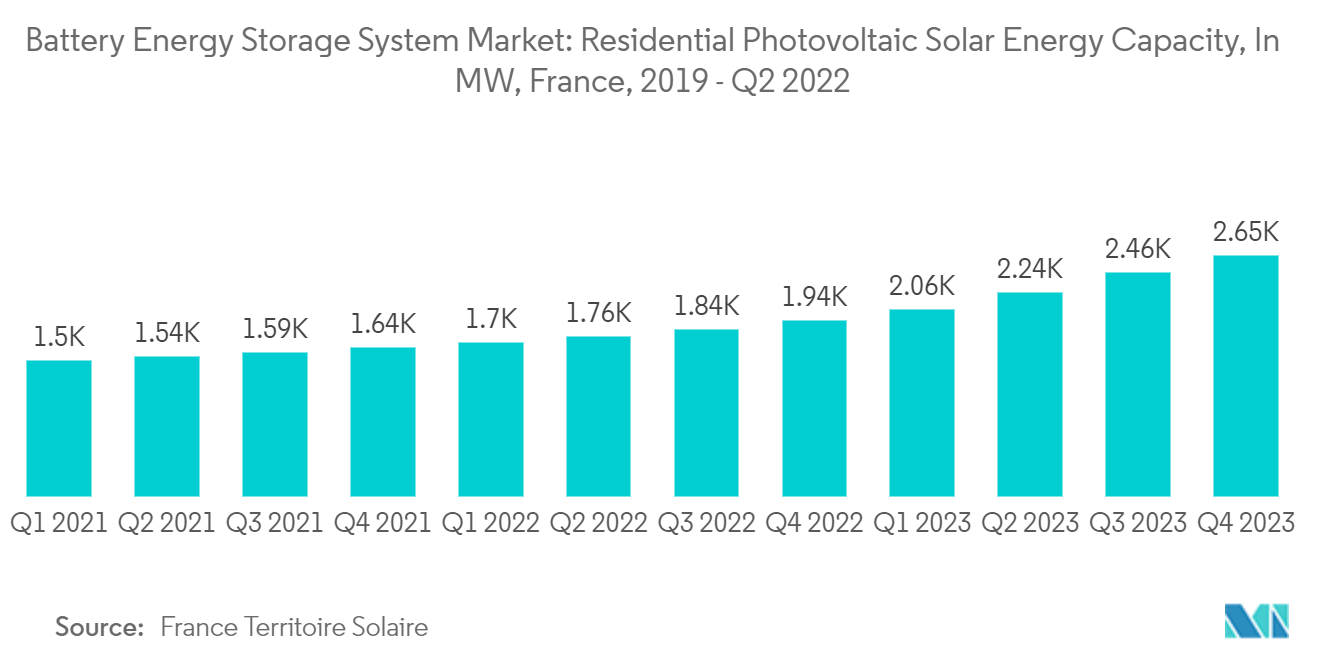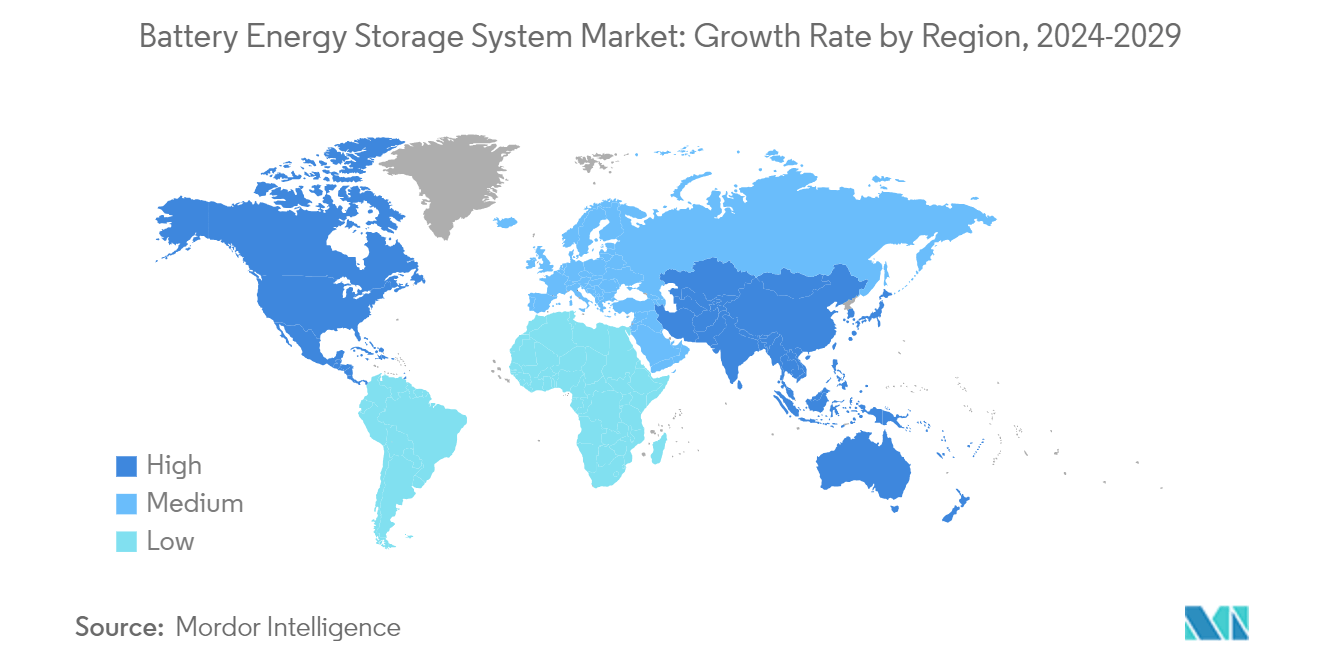Market Trends of Battery Energy Storage System Industry
Residential Expected to be the Fastest-growing Segment
- Residential energy storage systems are small-scale rechargeable batteries paired with distributed generation sources, mainly rooftop solar photovoltaic (PV) systems. Most residential battery energy storage systems (BESS) have a capacity of 2.5-25.2 kWh and a nominal voltage of nearly 50 V. However, systems with higher nominal voltage outputs are available in the market. Most of these Li-ion BESS are of Lithium Nickel Manganese Cobalt Oxide (NMC) or Lithium Iron Phosphate (LiFePO4) battery chemistry.
- In recent years, the energy storage system (ESS) has experienced significant growth, especially in the residential sector, along with rising investments in renewable energy infrastructure across the country. Electricity consumption in the residential sector is estimated to increase during the forecast period due to increasing annual disposable incomes, rising work-from-home trends, and rising power consumption across the globe. Energy storage systems are used for continuous power supply at homes during power outages at peak hours.
- According to SolarPower Europe, the European region installed residential battery energy storage of about 2.3 GWh in 2021, a two-fold increase from the previous year. The rise in installations was attributed to the mandatory installation of solar energy systems on new and renovated buildings as directed by the European Commission and battery storage targets as part of the National Clean Flexibility Plan as per ’ National Energy and Climate Plans (NECPs). This is likely to escalate the same in the future as well.
- Many European countries have charted energy storage installation targets. For instance, according to the Spanish Energy Storage Association, the nation aims to achieve 20 GW of energy storage installations by 2030 and 30 GW by 2050 as part of its new strategy.
- The cost of battery energy storage systems declined due to favorable government incentives and tax cuts. For instance, in March 2022, the UK government introduced new legislation, reversing the legislative changes brought in by the Court of Justice of the European Union, through which the government mandated a zero VAT rate for energy-saving technologies for residential accommodations, including residential BESS units. This tax cut would be valid for five years, after which the VAT rate will likely be revised to 5%.
- In renewable power sources, the majority of residential demand comes from the solar energy segment, which, in turn, creates demand for residential battery energy storage systems. For instance, according to France Territoire Solaire, in Q4 2023, France's total residential photovoltaic solar energy capacity accounted for 2,645 MW, an increase of 36.4 % compared to Q4 2022.
- In June 2022, Toyota entered the energy storage market by launching the O-Uchi Kyuden System, a residential battery product. Toyota launched a rated output of 5.5 kWh and a rated capacity of 8.7 kWh battery storage system. It uses the company's electric vehicle battery technology. When connected to a photovoltaic rooftop system, the system can power a home day and night. Initially, the company aimed to sell the storage system in Japan.
- Therefore, owing to these factors, the residential application is expected to create lucrative demand in the battery energy storage systems market during the forecast period.

Asia-Pacific Expected to Witness Faster Growth
- Asia-Pacific is expected to keep leading the market for battery energy storage over the next few years. The region consists of two main types of power grids, each with different characteristics and opportunities for energy storage systems. On one side are highly developed countries like Japan, South Korea, New Zealand, and Australia, as well as other large cities with advanced grids that work well and use the latest technologies.
- In the first half of 2023, China's new energy storage continued to develop at a high speed, with 850 projects (including planning, under construction, and commissioned projects), over twice that of the same period in 2022. The newly commissioned scale is 8.0GW/16.7 GWh, higher than the new scale level last year (7.3GW/15.9GWh) in 2022. The newly added projects were mainly put into operation in June, and the capacity reached 3.95GW/8.31GWh, accounting for 50% of the total increased capacity of operating projects in the first half of 2023. Further, it is expected that it will likely continue to maintain significant growth in the coming years.
- Similarly, in India, According to the government, the energy storage requirement is expected to soar to 73.93 GW (26.69 GW PSP and 47.24 GW BESS) with a significant storage capacity of 411.4 GWh by 2031-32. To develop the energy storage capacity from 2022 to 2032, an estimated fund requirement of over INR 54,203 crore for PSP and USD 6.7 billion for BESS is anticipated.
- Further, CEA has also set its sights on the long-term, projecting that by 2047, the country's energy storage demand will likely reach about 320 GW (90 GW PSP and 230 GW BESS) with a total energy storage capacity of 2,380 GWh, aligning with the country's aim to achieve the net zero emissions by 2070 and the rapid renewable energy growth.
- According to the Statistical Review of World Energy Data, in the Asia Pacific region, electricity generation will increase by 4% in 2022 as compared to 2021, the majority due to renewable sources of energy. Furthermore, the Japanese government has set a goal of reaching carbon neutrality by 2050. It intends to boost production from renewables in the overall energy generation to 36-38% by 2030, with solar and wind accounting for 19-21%. The country's prior objective was for renewables to increase from 18% to 22-24% in 2019-2020.
- China is investing heavily in battery energy storage systems (BESS), targeting 100 GW energy storage capacity by 2030. The 14th FYP set the tone to support all types of BESS, including novel lithium-ion, sodium-ion, lead-carbon, and redox flow. The battery energy storages have the advantages of high capacity, low cost, long life cycles, and fast response times. The goal is to boost the build-out of independently owned battery energy storage facilities to support and balance the rapidly growing but intermittent generation capacity from wind turbines and solar panels in the coming years.
- Furthermore, in September 2023, the Union Cabinet of India approved the viability gap funding scheme (VGF) to create a robust storage system for excess wind and solar power production. A total of 4,000 megawatt hours (MWh) of Battery Energy Storage System (BESS) projects will be developed by FY31 under the scheme. An initial outlay of USD 1,128.18 million, including budgetary support of USD 451.27 million, has been provided under the scheme.
- Therefore, owing to such factors, Asia-Pacific is expected to dominate the market during the forecast period.


